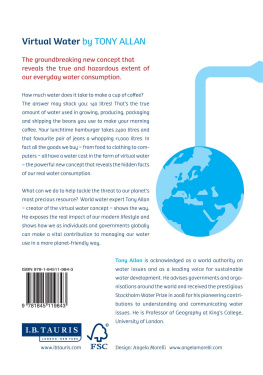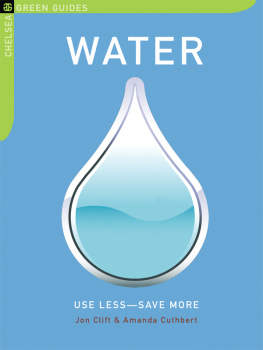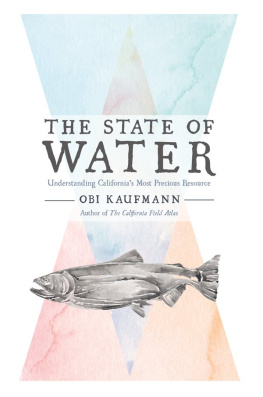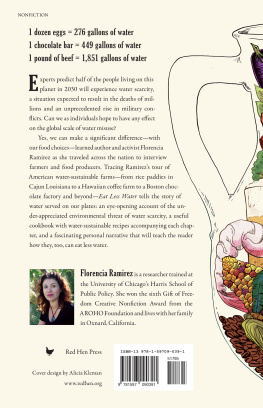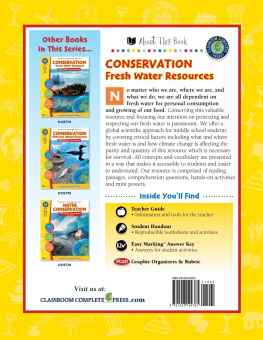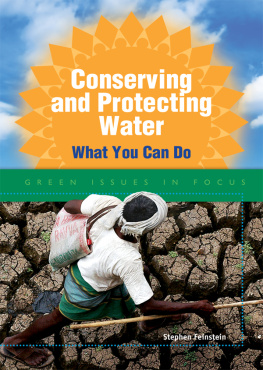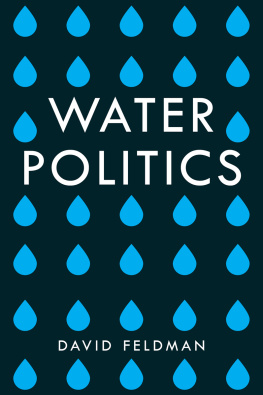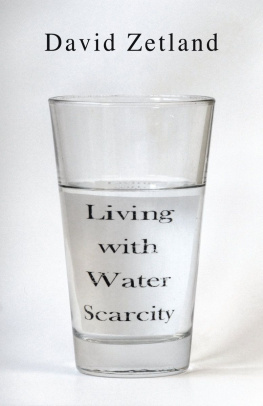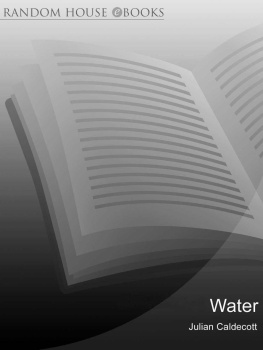
Published in 2011 by I.B. Tauris & Co. Ltd
6 Salem Road, London W2 4BU
175 Fifth Avenue, New York NY 10010
www.ibtauris.com
Distributed in the United States and Canada exclusively by Palgrave Macmillan
175 Fifth Avenue, New York NY 10010
Copyright J. A. Tony Allan 2011
Copyright virtual-water icons and illustrations Angela Morelli 2006-11
The right of J. A. Tony Allan to be identified as the author of this work has been asserted by him in accordance with the Copyright, Designs and Patents Act 1988.
All rights reserved. Except for brief quotations in a review, this book, or any part thereof, may not be reproduced, stored in or introduced into a retrieval system, or transmitted, in any form or by any means, electronic, mechanical, photocopying, recording or otherwise, without the prior written permission of the publisher.
ISBN:
978 1 84511 984 3 paperback
978 1 84511 983 6 hardback
eISBN:
978 0 85773 050 3
A full CIP record for this book is available from the British Library
A full CIP record is available from the Library of Congress
Library of Congress Catalog Card Number: available
Designed and typeset by Angela Morelli, London, UK
List of Figures
I dedicate this book to Murray Watson, in recognition of his inspired contribution to ecological sciences and the monitoring and evaluation of the natural resources of Africa and South-east Asia. And for touching so many with his unforgettable integrity and commitment.
And to Mary who continues to remind me that people do not like being written about.
Preface
Halfway through the past half century a few wise folk realised that we could no longer do wrong and stupid things to the water environment. We needed to start doing the right things even if they could only be done a little badly. Rapid increases in the global population, in industrialisation, urbanisation and privatisation, together placed immense strains on local water resources. The dangerous consequences of farmers being tempted to pull more and more water out of limited local water environments became painfully evident. The inappropriate production of crops that love to grow at temperatures at which we humans need expensive air conditioning devastated vast tracts of land. We dried up one of the biggest inland seas in the world in Central Asia, at least one major river in the US and another one in China. Capitalism and communism proved to have the same self-destructive tendencies.
Environmental activists were the first to spot that societies had been doing too many wrong things spectacularly well. The global atmosphere on which we all depend had been heated and polluted, so that climate changed. Surface water resources and groundwater had been over-pumped and polluted locally. Damaged water-resource hotspots became evident. Each local crisis reinforced the paradox that the most water-scarce regions were actually exporting water in the form of the water embedded in water-intensive crops to regions that were much better endowed with water.
Between 1800 and the 1970s politicians liked the things that engineers had done for them. Engineers had shown that it was possible to banish discomfort, ill-health and reduce social strife. But by the 1970s water engineers found themselves having to catch up with new ideas on the value of water. Urgent problems associated with massive environmental uncertainties could no longer be automatically remedied by concrete infrastructures. The voice given to the environment changed the discourse.
This book acknowledges the massive contribution of the hydraulic mission. But the main purpose is to draw attention to two of the very important agents who will in future determine whether or not the population of the world will be water secure. The first is the farmer. The second is ourselves the consumers of food. Farmers, by deploying a lot of inputs wisely or not determine whether they get high crop yields that use water effectively. We consumers, and our food choices, at the other end of the supply chain determine how much water is diverted into crop and livestock production. Our food preferences, our tendencies to waste food, our increasing longevity and our other demographic tendencies, determine the demands made on the water environment.
The aim of this book is to get both food consumers and farmers to grasp their role in future global water security. Other agents in the food supply chain the food commodity traders, the food processing and retailing corporations are also important target audiences. As are the governments of over-powerful economies that distort global trade.
Currently, and increasingly in future global financial markets, sovereign wealth funds will determine global water and food security and whether it has been achieved by sustainably intensive means.
The concept of virtual-water trade and water footprints will be used to explore the food supply chain and trade relations. It will be shown that global commodity production and trade enable local water security. The concept of virtual water, coined in the early 1990s, has had to live with the anger that its revelations sparked. Governments and societies existing in blissful apparent water security made possible by virtual-water trade, easily constructed arguments that resisted its adoption. Two decades on they can still drown the idea if it distresses their citizens. But it is now commonplace for virtual water to have a prominent place in any analysis of water security. And understanding the vital role that virtual water plays in global water security will help consumers, their governments and corporations to make the choices that will secure livelihoods, societies and the future of our planet.
The water-footprint statistics used in the book should be regarded as first approximations. They have been developed by Arjen Hoekstra and his network of researchers. New approaches, heroic assumptions and reliance on global datasets have been unavoidable. More accurate numbers based on more precise methods are being developed at the national and sub-national levels.
Acknowledgements
Books get written despite. Despite competing time demands. Despite the impossibility of distilling complexity. And especially despite the problem of writing convincing prose that simplifies the distilled complexity that the reader wants. This book exists because a number of good people had faith and wanted to see distilled complexity.
David Stonestreet has been a committed and supportive publisher throughout. He also recruited two wonderful professionals to enhance the project. Michael Flexer fixed the language register and Angela Morelli designed the graphics and the book.
My past two decades of almost five in science have been the best of all. Somehow one has been able to focus on water-resource issues and stop dabbling elsewhere. It has been fun to spot a number of ideas that thousands of other scientists and millions of engineers in the water sector have not. It has been a uniquely pleasant experience to watch the ideas gain currency without them being captured or devalued yet. One or two are original. Others are the result of the amiability of the water professional community and of the synergies they generate. I feel privileged to have had the chance to engage with great hydrogeologists such as Mike Edmunds, Alan MacDonald, Richard Taylor and Ramon Llamas. And with deeply cerebral hydrologists such as Malin Falkenmark. Also with prominent water engineers, enriched by the ideas of economics, such as Peter Rogers and John Briscoe, and especially Jack Keller. Jack came up after a short presentation to tell me that I had just conceptualised his fifty-year career in water science and policy. Bless him: he also liked the idea of virtual water. Dipak Gywali is another exceptional engineer. In his case, one who has journeyed far and wide in the terrain of social theory to the great benefit of international water science. Munther Haddadin has been a very special friend, engineer and ally in promoting the concept of shadow water, which he coined also in the early 1990s. Munther has hugely promoted the concepts in the Middle East, where they are especially relevant. I have also greatly profited from the abrasive, sometimes patronising, rigour of economist friends. They are not comfortable that a non-economist identified and developed the idea of virtual water and they concede it only a tiny place in the economics firmament. I thank very warmly Steve Merrett, Jeremy Berkoff, Dennis Wichelns, Alberto Garrido and Chris Perry who is as much a water scientist as an economist. All have helped tether the idea. I have discovered one cannot speak to enough farmers if one wants to understand the effective consumptive use of water. My access to the importance of the role of farming and farmers and the need to speak to more of them has come from my friends Brian and Lynne Chatterton.
Next page
